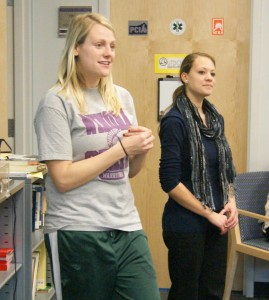
Matthew Seckora/Winonan
Courtney Kowalke/Winonan
Winona State University’s latest Wellness Wednesday highlighted the importance of super foods.
Presented by health and wellness advocates Emily Birch, Melissa Edel and Ashley Stevens, the event was attended by 26 students.
Super foods are “a special category of foods found in nature that are sparse in calories and dense in nutrition,” Stevens said.
Currently, “super food” is not a term used commonly in medical or dietary fields.
According to WebMD, the term “is sometimes used to describe food with high nutrient or phytochemical content that may confer health benefits, with few properties considered to be negative, such as being high in saturated fats or artificial ingredients, food additives or contaminants.”
According to Dr. Steven Pratt of CNN, a super food has three qualifications.
It has to be readily available to the public, it has to contain nutrients that are known to enhance longevity, and its health benefits have to be backed by peer-reviewed, scientific studies.
“These foods were chosen because they contain high concentrations of crucial nutrients, as well as the fact that many of them are low in calories,” he said.
He also said, “Foods containing these nutrients have been proven to help prevent and, in some cases, reverse the well-known effects of aging, including cardiovascular disease, Type II Diabetes, hypertension and certain cancers.”
“The most common thing I have heard is how much weight people lost without trying to lose weight,” Pratt added. “It’s the non-diet diet. It’s food you can eat for a lifetime.”
According to WebMD, the super foods are that offer the best health protection are beans, blueberries, broccoli, oats, oranges, pumpkin, salmon, soy, spinach, green or black tea, tomatoes, turkey, walnuts and yogurt.
Super foods can also act as mood enhancers. As highlighted by the advocates, oranges reduce stress, Kefir milk reduces anxiety, and asparagus reduces mood swings.
Edel noted that combining super foods provides the best array of nutritional benefits.
The advocates noted that each month offers different super foods that are in season.
“These particular foods are readily available and cheaper,” Stevens said.
Among the super foods of November are clementines, pears, sweet potatoes, cauliflower, cranberries, leeks, turnips and winter squash.
All these foods are nutritious and versatile.
Each can be used in different recipes to create many different combinations of food.
Birch, Edel and Stevens also highlighted the importance of super foods containing antioxidants and phytochemicals, which are chemical compounds that occur naturally in plants that are responsible for color and organoleptic properties, such as the deep purple of blueberries and smell of garlic.
The term is generally used to refer to those chemicals that may have biological significance but are not established as essential nutrients.
“The more colorful your plate, the more super foods you have on it,” Birch said.
Foods containing such nutrients often help the human body fight the effects of free radicals and cancer.
Scientists estimate that there may be as many as 10,000 different phytochemicals having the potential to affect diseases such as cancer, stroke or metabolic syndrome.
The group also agreed it is important for students to learn the health benefits of super foods now so they could get a boost of extra natural energy before the end of the semester.
“You should start eating now to avoid getting sick during finals week,” Stevens said.
To celebrate the last day of October, the three advocates prepared pumpkin smoothies for the students in attendance.
The smoothies were not prepared with many extra ingredients, so as not to needlessly detract from the base super food.
Frozen Greek yogurt-dipped strawberries were also served.
“A lot of these recipes and ideas can be found on Pinterest,” Birch said, suggesting curious participants search “super foods” on the social photo sharing website.
Contact Courtney at [email protected]










































